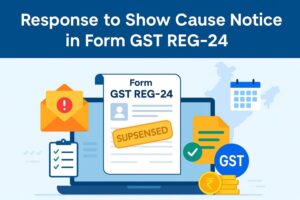Impact and Rate Changes of GST on Two-wheeler Insurance
- 22 Aug 24
- 14 mins

Impact and Rate Changes of GST on Two-wheeler Insurance
- GST on Two-wheeler Insurance Policies in India
- Impact of GST on the Bike Insurance Market
- GST and Insurance Policies
- How Does GST on Two-wheeler Insurance Affect Customers?
- GST's Impact on the Two-wheeler Industry
- Bike Insurance Policy Rates Post-GST
- Can You Add a GST Number to Your Bike Insurance Policy?
Key Takeaways
- The introduction of GST has standardized the tax rate on two-wheeler insurance premiums to 18%, replacing various previous taxes.
- GST on two-wheeler insurance has increased premium costs but improved transparency and consistency in pricing.
- Electric bikes benefit from a reduced GST rate of 5%, encouraging adoption of environmentally friendly transportation.
- Adding a GST number to a bike insurance policy allows businesses to claim input tax credits, reducing their overall tax burden.
- The streamlined GST tax structure has facilitated better compliance and administrative efficiency for insurance companies and manufacturers.
The introduction of the Goods and Services Tax (GST) in India brought significant changes to the taxation norms across various sectors, including the automobile industry. One notable area of impact has been the insurance market, particularly for two-wheelers. Before GST, the insurance premium for bikes was subject to service tax and other levies, which contributed to the overall cost of ownership. The GST regime aimed to simplify this by unifying the tax structure under a single, comprehensive framework.
With the implementation of GST, the tax rate on two-wheeler insurance premiums was standardized to 18%. This rate applies uniformly across various types of policies, including comprehensive cover and third-party coverage. The GST on bikes has thus streamlined the taxation process, replacing the previous tax structure with a more transparent system.
This change in tax rates has had a direct impact on the premium costs for bike insurance policies. Insurance companies have adjusted their pricing models to reflect the GST Base rate, ensuring compliance with the new regulations. While the 18% GST rate has increased the tax component of insurance premiums compared to the previous tax structure, it has also provided clarity and consistency in the market.
Overall, the shift to GST has brought both challenges and benefits. While premium costs have seen an uptick due to the higher tax rate, the streamlined tax structure has made it easier for consumers to understand and manage their insurance expenses. The new system also aligns with broader government goals of improving transparency and efficiency in tax administration.
GST on Two-wheeler Insurance Policies in India

In India, two-wheeler insurance policies are now subject to the Goods and Services Tax (GST), which has replaced the previous service tax and other local levies. This change, initiated by the Indian government, aims to simplify and unify the tax structure across the nation. The current taxation norms under GST impose an 18% tax on the insurance premiums for two-wheelers, impacting both comprehensive policies and third-party coverage.
This GST percentage has standardized the tax rate for two-wheeler insurance, making it easier for consumers to understand the cost implications of their insurance policies. Before the GST era, different states had varying tax rates, leading to confusion and inconsistencies in policy pricing. The implementation of a uniform GST rate has eliminated these disparities, providing a clear and predictable tax structure.
Insurance companies have had to adjust their operations to comply with these new regulations. The policy wording and premium calculations have been revised to incorporate the applicable GST rate, ensuring transparency and compliance with the central-level directives. This has streamlined the process of buying and renewing two-wheeler insurance, making it more straightforward for policyholders.
However, the shift to an 18% GST rate has also led to an increase in the overall cost of insurance premiums. While this has raised concerns among some consumers, the benefits of a unified tax system, such as reduced administrative burdens and clearer pricing, are significant. The GST on bikes, including their insurance, aligns with the broader goals of the Indian government to simplify and modernize the taxation system.
Impact of GST on the Bike Insurance Market
The bike insurance market has experienced notable changes since the implementation of GST. The shift from the previous tax structure to a unified GST framework has had profound effects on how insurance policies are priced and managed. The imposition of an 18% GST rate on insurance premiums has streamlined the taxation process but also brought about an increase in premium costs for policyholders.
Before GST, the bike insurance market operated under a complex web of taxes, including service tax and various state-level levies. This made the pricing of insurance policies less transparent and more difficult for consumers to navigate. The introduction of GST has replaced these multiple taxes with a single, comprehensive tax, simplifying the process and providing clearer pricing structures.
Insurance companies have had to adapt to these changes by revising their premium calculations and policy wording to incorporate the new GST rates. This adjustment has ensured compliance with the current taxation norms while also providing more straightforward and transparent pricing for consumers. The GST rates on bike insurance have thus contributed to a more predictable and streamlined market environment.
The impact of GST on the bike insurance market extends beyond just pricing. The uniform tax rate has facilitated better compliance and reduced administrative burdens for insurance providers. However, the higher tax rate compared to the pre-GST era has also led to higher costs for consumers. Despite this, the benefits of a simplified and standardized tax system are significant, providing long-term advantages for both insurers and policyholders.
GST and Insurance Policies
The implementation of GST has had a wide-ranging impact on insurance policies, including those for two-wheelers. GST has unified the tax structure across the country, applying an 18% tax rate to insurance premiums. This change has replaced the previous service tax and various local levies, creating a more streamlined and transparent system.
For two-wheeler insurance, the GST rate applies to all types of policies, including comprehensive cover and third-party coverage. This uniform rate has simplified the taxation process, making it easier for consumers to understand the cost implications of their insurance policies. The policy wording and premium calculations have been adjusted to reflect the new tax norms, ensuring compliance and transparency.
💡If you want to pay your GST with Credit Card, then download Pice Business Payment App. Pice is the one stop app for all paying all your business expenses.
The introduction of GST has also had implications for the broader insurance market. By replacing the previous tax structure with a single, comprehensive tax, GST has reduced administrative burdens and improved compliance among insurance companies. This has led to more consistent pricing and better alignment with the central government's objectives of modernizing the tax system.
However, the higher GST rate compared to the pre-GST era has increased the overall cost of insurance premiums. This has raised concerns among consumers about the affordability of insurance policies. Despite this, the benefits of a unified tax system, such as clearer pricing and reduced complexity, are significant. The impact of GST on insurance policies underscores the importance of balancing tax revenue with consumer affordability and market efficiency.
How Does GST on Two-wheeler Insurance Affect Customers?

The introduction of GST on two-wheeler insurance has had a noticeable impact on customers. The 18% GST rate on insurance premiums has replaced the previous tax structure, leading to changes in the cost and transparency of insurance policies. This new tax structure has several implications for consumers, influencing their purchasing decisions and overall experience with bike insurance.
One of the primary effects of GST on two-wheeler insurance is the increase in premium costs. Under the previous tax structure, various state and central taxes were applied, often resulting in lower overall tax rates. The standardized 18% GST rate has increased the tax component of insurance premiums, making policies more expensive for customers. This change has prompted some consumers to reconsider their coverage options, particularly those who prioritize affordability.
Despite the increase in costs, the GST regime has brought about greater transparency in policy pricing. The uniform tax rate eliminates the confusion caused by varying state-level taxes, making it easier for customers to understand the true cost of their insurance policies. This clarity is beneficial for customers, allowing them to make more informed decisions when purchasing or renewing their insurance.
Additionally, the implementation of GST has simplified the administrative process for insurance companies, leading to more efficient operations and potentially better customer service. The streamlined tax structure reduces the burden of compliance and enables insurers to focus on delivering value to their policyholders.
Overall, while the GST on two-wheeler insurance has increased premium costs, it has also improved transparency and simplified the taxation process, providing long-term benefits for customers in the bike insurance market.
GST's Impact on the Two-wheeler Industry
The implementation of GST has significantly impacted the two-wheeler industry in India, affecting various aspects of the market, including manufacturing, pricing, and consumer behavior. By replacing multiple state and central taxes with a single, unified tax, GST has streamlined the tax structure and brought about several key changes in the industry.
One of the most notable impacts of GST on the two-wheeler industry is the standardization of tax rates. The GST rates for motorcycles and scooters are determined based on engine capacity and type. Regular bikes with engine capacities below 350 cc attract an 18% GST rate, while those with larger engines are taxed at 28%. Electric bikes benefit from a lower GST rate of 5%, encouraging the adoption of electric vehicles and aligning with the government's sustainability goals.
The uniform tax rate has simplified the pricing of two-wheelers, making it easier for manufacturers and dealers to set competitive prices. This has improved transparency in the market, allowing consumers to make more informed purchasing decisions. However, the higher GST rate for luxury bikes has increased their overall cost, impacting demand in this segment.
The GST regime has also facilitated better compliance and reduced administrative burdens for two-wheeler manufacturers. The input tax credit mechanism allows manufacturers to claim credit for the GST paid on inputs, reducing the overall tax burden and improving cash flow. This system supports the growth of the two-wheeler industry by enabling manufacturers to maintain competitive pricing and invest in innovation.
Overall, GST's impact on the two-wheeler industry has been transformative, bringing both challenges and benefits. The streamlined tax structure has improved market efficiency and transparency, supporting the industry's long-term growth and alignment with broader economic and environmental goals.
Bike Insurance Policy Rates Post-GST
The introduction of GST has led to changes in bike insurance policy rates, impacting both the cost and structure of premiums. The 18% GST rate on insurance premiums has replaced the previous service tax and other local levies, leading to an increase in the overall cost of bike insurance policies.
Under the previous tax structure, bike insurance premiums were subject to various state and central taxes, often resulting in lower overall tax rates. The shift to a standardized 18% GST rate has increased the tax component of premiums, making policies more expensive for consumers. This change has affected the affordability of bike insurance, particularly for those seeking comprehensive coverage.
Despite the increase in costs, the GST regime has brought about greater transparency and consistency in policy pricing. The uniform tax rate eliminates the confusion caused by varying state-level taxes, making it easier for consumers to understand the true cost of their insurance policies. This clarity is beneficial for customers, allowing them to make more informed decisions when purchasing or renewing their insurance.
Insurance companies have also had to adapt to the new tax norms by revising their premium calculations and policy wording. This adjustment has ensured compliance with the current taxation norms and provided a more straightforward and transparent pricing structure for consumers. The impact of GST on bike insurance policy rates underscores the importance of balancing tax revenue with consumer affordability and market efficiency.
Overall, while the GST on bike insurance has increased premium costs, it has also improved transparency and simplified the taxation process, providing long-term benefits for both insurers and policyholders in the bike insurance market.
Can You Add a GST Number to Your Bike Insurance Policy?
Yes, you can add a GST number to your bike insurance policy if you are a business owner or a registered entity under GST. Adding a GST number to your insurance policy allows you to claim input tax credit (ITC) for the GST paid on your insurance premiums, reducing the overall tax burden on your business.
To add a GST number to your bike insurance policy, you need to provide the insurance company with your GST registration details at the time of policy purchase or renewal. The insurance company will then include your GST number in the policy documentation, ensuring that the GST paid on the premiums is accounted for under your business's GST records.
Adding a GST number to your bike insurance policy can provide significant financial benefits for businesses. The input tax credit mechanism allows you to offset the GST paid on insurance premiums against the GST collected on your business's sales, reducing the overall tax liability. This can improve cash flow and support the financial health of your business.
It is important to ensure that the GST number provided is accurate and up-to-date to avoid any compliance issues. The insurance company will verify the GST details and ensure that they are correctly reflected in the policy documentation. By adding a GST number to your bike insurance policy, you can take advantage of the benefits provided by the GST regime, making your business operations more efficient and cost-effective.
 By
By 

















